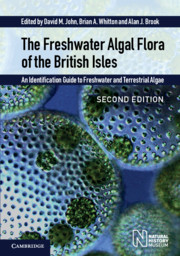 The Freshwater Algal Flora of the British Isles
The Freshwater Algal Flora of the British Isles Published online by Cambridge University Press: 12 January 2024
The algae are oxygen-producing, mainly aquatic organisms possessing enormous morphological, cytological, molecular and reproductive diversity. Modern studies have led to the recognition that algae represent a number of evolutionary lines or lineages, almost all of which are represented in the British freshwater flora. Most of these lineages probably arose independently as a result of endosymbiosis. There has been a tendency by protozoologists to adopt what has been termed a ‘protistan’ view and to place these lineages into the Protista, a kingdom that itself is unnatural (Corliss, 1994). The majority of the lineages are eukaryotic, in which the cells have a double membrane surrounding the nucleus and most other organelles such as chloroplasts. Another evolutionary line, the Cyanobacteria (Cyanophyta or blue-green algae) are often considered together with other algae, although these organisms are prokaryotic (membrane-bound organelles absent) and more closely related to the bacteria.
A few algae have photosynthetic structures known as cyanelles, which in many ways are intermediate between a chloroplast and a free-living bluegreen alga. In most such cases, the rest of the cell resembles quite closely other species of algae with normal chloroplasts. It is likely that the cyanelles have evolved relatively recently from free-living cyanobacteria. However, in the case of Glaucocystis nostochinearum, which has conspicuous cyanelles, there is still doubt about its relationships and it is here classified in its own phylum, the Glaucophyta. Some other organisms possess no photosynthetic structure, but are otherwise quite similar to those that have chloroplasts. These are often treated as protozoans, but clearly belong in the same phyla as the related photosynthetic organisms. Most examples are in the flagellated phyla (Euglenophyta, Cryptophyta, Dinophyta and Chrysophyta). The first three, but not the Chrysophyta, are nowincluded in this edition.
What constitutes an algal species has been the subject of much debate (see John and Maggs, 1997, for a review). Most species are recognized by discontinuities in sets of morphological characters observed with the light microscope, so that algal systematics is largely based on what has been termed ‘the morphospecies concept’. Culture studies have frequently shown that species concepts based solely on characters observed in field-collected material are often too narrow and the taxonomic validity of many of the characters used is open to question (see Trainor, 1998, and his comments in a review of the genus Scenedesmus sensu lato).
To save this book to your Kindle, first ensure no-reply@cambridge.org is added to your Approved Personal Document E-mail List under your Personal Document Settings on the Manage Your Content and Devices page of your Amazon account. Then enter the ‘name’ part of your Kindle email address below. Find out more about saving to your Kindle.
Note you can select to save to either the @free.kindle.com or @kindle.com variations. ‘@free.kindle.com’ emails are free but can only be saved to your device when it is connected to wi-fi. ‘@kindle.com’ emails can be delivered even when you are not connected to wi-fi, but note that service fees apply.
Find out more about the Kindle Personal Document Service.
To save content items to your account, please confirm that you agree to abide by our usage policies. If this is the first time you use this feature, you will be asked to authorise Cambridge Core to connect with your account. Find out more about saving content to Dropbox.
To save content items to your account, please confirm that you agree to abide by our usage policies. If this is the first time you use this feature, you will be asked to authorise Cambridge Core to connect with your account. Find out more about saving content to Google Drive.